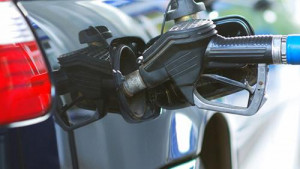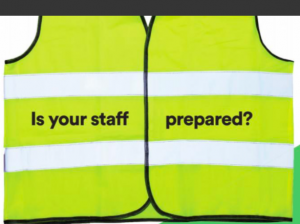8 key focus areas for improving fuel site safety

Gas stations are dangerous places. Consider that in the U.S. close to 30 forecourt workers are killed on the job each year. Another 2.3% of workers are injured with about one percent requiring retraining or a transfer due to the severity of injury. Are you paying attention to the hazards at your site?
According to National Energy Equipment’s national health, safety and environment specialist Michael Lamont, the leading hazard for workers is vehicles and pedestrian traffic at forecourt. “People are often distracted and not paying attention when they drive in to fuel. When our crews are working on equipment, there is a real hazard to their safety. To mitigate this our teams are knowledgeable in Petroleum Oriented Safety Training (POST) (www.posttraining.ca) and they place pylons, flags, barriers and service vehicles per standard to protect staff,” he says, noting that POST is an industry- led program that offers online courses and annual get-togethers such as safety forums at the Convenience U CARWACS Show.
The Canadian Fuels Association is on top of safety and in 2019 commissioned a study (“Risk Associated with Cell Phone Use During Refuelling”) that discovered the chance of starting a fire at the pumps with a cellphone is less than one in 10 billion. The far greater safety risk is mobile device distraction where phone use increases the risk of spills and other pump-side incidents. And, while the Technical Standards and Safety Authority (TSSA) permits cellphone use for pay-at-pump applications, they caution about the need for customer focus during refuelling. They advise operators to interrupt fuelling should they observe a customer calling or texting while at the dispenser.
Lamont suggests good safety practice often comes down to training. “Do your staff know the size of the storage tanks? Do they know where to locate the vapour recovery? Are they clearing away ice from fills? Do they know what to do in the event of a spill or tank leak? When do you hit the ‘E Stop’ button? Training prepares staff for worst case scenarios and helps keep them and customers safe,” he says.
Rob Hoffman, director, government and stakeholder relations with the Canadian Fuels Association, agrees with Lamont. He suggests that alongside training protocols, engineered controls such as state-of-the-art dispenser design and technology greatly reduce the risk associated with the flammable nature of fuels. “Incidents at the pumps are very rare today thanks to continuous improvements from the industry." However, he concludes, "distracted behaviour from customers is still the leading source of concern when it comes to safety on site. For best practice to occur, customers need to be more aware and staff need to be aware of customers and how they may act.”

8 key areas for safety focus
- Fuel Storage
Fuel storage poses several risks. These include fire/explosion, environmental damage and health concerns.
*Ensure staff are adequately trained (keep all training records).
*Maintain and monitor storage tanks and dispensers.
*Identify hazardous areas and control all sources of ignition – placard site with appropriate warning and hazard signs.
2. Vehicle Movement
Cars and vehicles pose a considerable hazard to forecourt personnel and customers as well as create the opportunity for equipment damage through collision.
*Design a safe system of traffic movement such as a one-way system for entering and exiting the forecourt and clearly sign it.
*Offer a designated parking area close to the c-store and away from the fuel dispensers.
*Create a barrier to protect structures such as fuel tanks and liquified petroleum gas (LPG) storage areas.
3. Hazardous Substances
Car wash and commercial cleaning products can be harmful if staff are incorrectly exposed though spillage or leaking containers. These can lead to respiratory problems, serious skin irritations or chemical burns.
*Store hazardous products such as chemicals in their original containers.
*Obtainand keep on hand manufacturer hazard data sheet information on all substances stored and used on the premises.
*Train staff and provide appropriate protective clothing.
4. Manual Handling
Access covers to storage tanks; LPG cylinders and large cleaning fluid containers are heavy. Moving these may cause injury if staff are not trained to see the hazard.
*Train staff in proper lifting techniques.
*Provide suitable equipment such as lifts for removing access covers and hand trucks.
*Eliminate all unnecessary manual handling.
5. Slips and Trips
Fuel and oil spillage at forecourt can create slip hazards for both customers and staff. Winter ice and snow are another threat that can see people tumble or cars slide into dispensers.
*Use an industrial salt mixed with fine gravel or sand to spread on the forecourt during icy conditions.
*Absorb and clean up any fuel or oil spill.
*Train staff on how to deal with minor fuel spillages.
6. Electricity
Poorly maintained equipment and shoddy system installs increase the risk of electrical accidents in an environment where there are both power and wet conditions.
*Make certain all electrical equipment used out of doors is suitably insulated.
*All electrical controlling machinery should be clearly labelled and easily accessible.
*Check that the installation of electrical equipment (especially for car wash) is suitable for a wet environment and has adequate protection from mechanical damage.
*Make certain there is a readily accessible emergency stop button to halt car wash operation.
7. Fire
Fueling sites are filled with potential fire hazards. It's important to keep escape routes clear.
*Remove any obstructions at exits.
*Have regular checks to ensure that compliance is occurring.
*Have trash and waste cleared regularly and hazardous materials removed only by a certified waste disposal firm.
8. Violence to Staff
Robberies and drive-offs are a considerable hazard to staff.
*Get involved with local police programs and investigate national best practices.
*Consider the use of closed-circuit television, panic alarms and other security measures.
*Develop a robbery or drive-off procedure in the safety manual and drill staff to make sure they follow through.
Originally published in the May/June issue of Octane.
